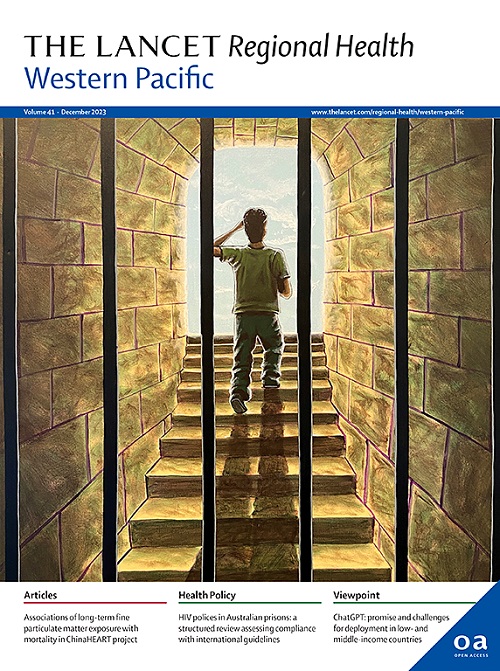Twelve-month prevalence of DSM-5 mental disorders and the psychosocial correlates- a child and adolescent psychiatric epidemiologic survey in Hong Kong SAR
IF 7.6
1区 医学
Q1 HEALTH CARE SCIENCES & SERVICES
引用次数: 0
Abstract
Background
Childhood and adolescence, as critically important developmental stages, set the premise for the lifelong trajectory of health and well-being. Epidemiologic evidence abounds in purporting that half of all lifetime mental disorders begin in adolescence. Epidemiologic data based on structured clinical diagnostic assessments are disproportionately scarce in Asian countries that host fast-growing youth population along a wide socioeconomic spectrum in the course of globalisation.
Methods
A cross-sectional school-based epidemiologic survey was conducted on a representative random sample of children and adolescents aged 6–17 years from September 2019 to June 2023 in Hong Kong Special Administrative Region (Hong Kong SAR). The main diagnostic measures were 31 DSM-5 disorders assessed with Diagnostic Interview Schedule for Children, Version 5 (DISC-5) on the whole study sample. One parent/caregiver of each participant was interviewed for cases from primary schools. Separate parent/caregiver and student interviews were conducted for cases from secondary schools where research diagnoses derived from both sources in the adolescent/caregiver pair were combined at disorder level. A host of developmental and psychosocial factors were also collected. The study sample was reconstituted according to the discrepancy between the study population and official population data (census mid-year 2022 and Education Bureau) in terms of age, sex, ethnicity, household income and school type to give weight-adjusted prevalence estimation of various disorders.
Findings
The final weighted sample consisted of 6082 participants. The 12-month prevalence of having only one DSM-5 disorder was 13.5% (95% CI: 12.6–14.3%), while the 12-month prevalence of having two or more DSM-5 disorders was 11.0% (95% CI: 10.2–11.8%). The most prevalent disorders/categories of disorders were attention-deficit/hyperactivity disorder (ADHD) (10.2%, 95% CI: 9.4–11.0%); any disruptive, impulse control and conduct disorders (8.8%, CI:8.1–9.5%); any anxiety disorders (6.1%, 95% CI: 5.5–6.7%); any depressive disorders (5.4%, 95% CI: 4.8–6.0%). The 12-month prevalence rates of suicide ideation, plan, and attempt (not including the non-suicidal self-injury) were respectively 3.9% (95% CI: 3.4–4.4%), 1.9% (95% CI: 1.6–2.3%), 1.1% (95% CI: 0.8–1.3%). Parental anxiety and depressive symptoms, any clinically significant sleep disorder, and major school maladjustments (such as repeating a grade, school suspension, absenteeism) were significant factors associated positively (ORs: 1.1–3.37, p-values < 0.01–0.001) with ADHD, externalizing and internalizing disorders in multivariate logistic regressions that account for a multitude of developmental and environmental factors.
Interpretation
This study provides the first comprehensive mental health survey on children and adolescents that might inform other high-income regions in Asia and other robustly thriving economies in the coming decades. The common mental health problems present unmet needs in the school community and yet the related factors are accessible and potentially modifiable. Sustainable mental health initiatives should prioritise an integrated approach to the well-being of parent-child dyad, early detection and intervention targeting sleep disorders, and build a holistic learning support environment in school communities.
Funding
Health and Medical Research Fund, Health Bureau, Hong Kong Special Administrative Region (MHS-P1(Part 1)-CUHK).
《精神疾病诊断与统计手册》第5版精神障碍的12个月患病率及其社会心理相关因素——香港特别行政区儿童及青少年精神病学流行病学调查
背景童年和青春期是极其重要的发育阶段,为一生的健康和幸福奠定了基础。大量流行病学证据表明,人一生中有一半的精神障碍始于青春期。在亚洲国家,基于结构化临床诊断评估的流行病学数据尤为匮乏,而这些国家的青少年人口在全球化过程中沿着广泛的社会经济谱系快速增长。方法:我们于2019年9月至2023年6月在香港特别行政区(香港特区)对具有代表性的6-17岁儿童和青少年进行了一次横断面校本流行病学调查。主要诊断指标是以儿童诊断访谈表第五版(DISC-5)评估整个研究样本的31种DSM-5疾病。对于来自小学的病例,每位受试者的一位家长/照顾者接受了访谈。对于中学的个案,则分别对家长/监护人和学生进行访谈,并将青少年/监护人双方的研究诊断结果合并为失调症。此外,还收集了一系列发展和社会心理因素。根据研究人口与官方人口数据(2022 年年中人口普查和教育局)在年龄、性别、种族、家庭收入和学校类型方面的差异,对研究样本进行重新组合,以得出各种失调症的加权患病率估计值。12个月内仅患有一种DSM-5障碍的患病率为13.5%(95% CI:12.6-14.3%),而患有两种或两种以上DSM-5障碍的患病率为11.0%(95% CI:10.2-11.8%)。最普遍的疾病/疾病类别是注意力缺陷/多动障碍(ADHD)(10.2%,95% CI:9.4-11.0%);任何破坏性、冲动控制和行为障碍(8.8%,CI:8.1-9.5%);任何焦虑障碍(6.1%,95% CI:5.5-6.7%);任何抑郁障碍(5.4%,95% CI:4.8-6.0%)。自杀意念、自杀计划和自杀未遂(不包括非自杀性自伤)的 12 个月患病率分别为 3.9% (95% CI: 3.4-4.4%)、1.9% (95% CI: 1.6-2.3%)、1.1% (95% CI: 0.8-1.3%)。父母的焦虑和抑郁症状、任何有临床意义的睡眠障碍以及严重的学校不适应(如留级、停学、旷课)都是与多动症、外显多动症(outside-highment)、多动症(outside-highment)和外显多动症(outside-highment)呈正相关的重要因素(ORs:1.1-3.37,p-values < 0.01-0.001)。这项研究首次对儿童和青少年进行了全面的心理健康调查,可能会为亚洲其他高收入地区以及未来几十年其他蓬勃发展的经济体提供参考。常见的心理健康问题是学校社区尚未得到满足的需求,但相关因素是可以获得的,也是有可能改变的。可持续的精神健康计划应优先考虑亲子关系的综合方法、针对睡眠障碍的早期检测和干预,以及在学校社区建立全面的学习支持环境。
本文章由计算机程序翻译,如有差异,请以英文原文为准。
求助全文
约1分钟内获得全文
求助全文
来源期刊

The Lancet Regional Health: Western Pacific
Medicine-Pediatrics, Perinatology and Child Health
CiteScore
8.80
自引率
2.80%
发文量
305
审稿时长
11 weeks
期刊介绍:
The Lancet Regional Health – Western Pacific, a gold open access journal, is an integral part of The Lancet's global initiative advocating for healthcare quality and access worldwide. It aims to advance clinical practice and health policy in the Western Pacific region, contributing to enhanced health outcomes. The journal publishes high-quality original research shedding light on clinical practice and health policy in the region. It also includes reviews, commentaries, and opinion pieces covering diverse regional health topics, such as infectious diseases, non-communicable diseases, child and adolescent health, maternal and reproductive health, aging health, mental health, the health workforce and systems, and health policy.
 求助内容:
求助内容: 应助结果提醒方式:
应助结果提醒方式:


